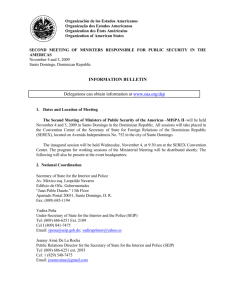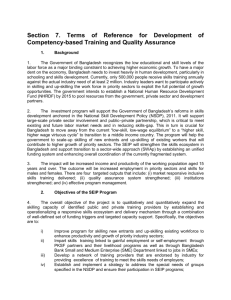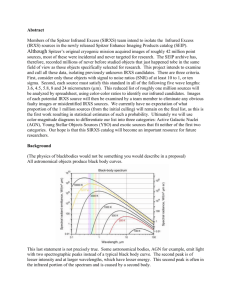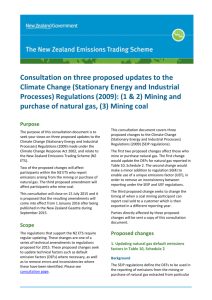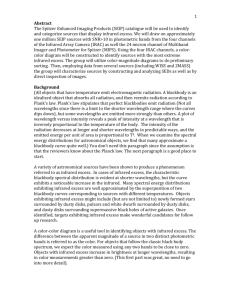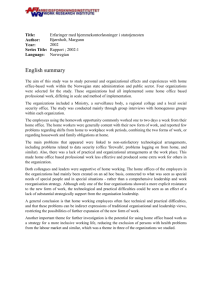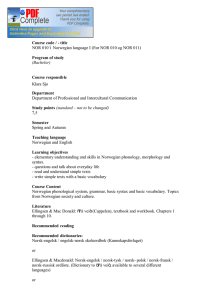Xxxxx - Høgskolen i Oslo
advertisement
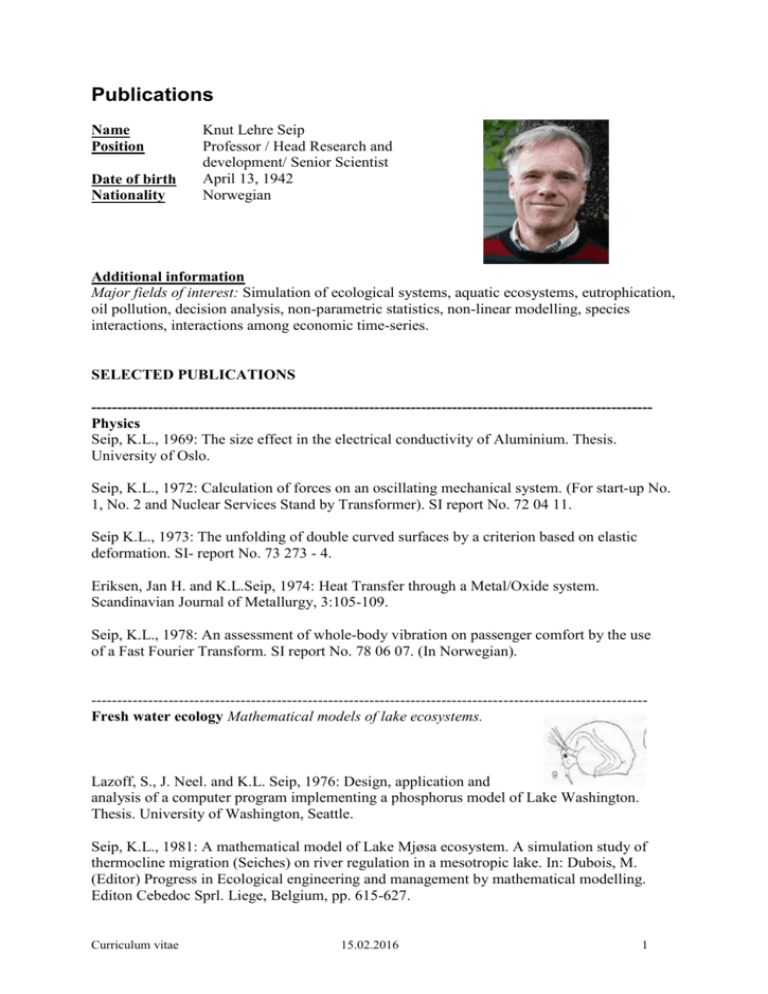
Publications Name Position Date of birth Nationality Knut Lehre Seip Professor / Head Research and development/ Senior Scientist April 13, 1942 Norwegian Additional information Major fields of interest: Simulation of ecological systems, aquatic ecosystems, eutrophication, oil pollution, decision analysis, non-parametric statistics, non-linear modelling, species interactions, interactions among economic time-series. SELECTED PUBLICATIONS ------------------------------------------------------------------------------------------------------------Physics Seip, K.L., 1969: The size effect in the electrical conductivity of Aluminium. Thesis. University of Oslo. Seip, K.L., 1972: Calculation of forces on an oscillating mechanical system. (For start-up No. 1, No. 2 and Nuclear Services Stand by Transformer). SI report No. 72 04 11. Seip K.L., 1973: The unfolding of double curved surfaces by a criterion based on elastic deformation. SI- report No. 73 273 - 4. Eriksen, Jan H. and K.L.Seip, 1974: Heat Transfer through a Metal/Oxide system. Scandinavian Journal of Metallurgy, 3:105-109. Seip, K.L., 1978: An assessment of whole-body vibration on passenger comfort by the use of a Fast Fourier Transform. SI report No. 78 06 07. (In Norwegian). -----------------------------------------------------------------------------------------------------------Fresh water ecology Mathematical models of lake ecosystems. Lazoff, S., J. Neel. and K.L. Seip, 1976: Design, application and analysis of a computer program implementing a phosphorus model of Lake Washington. Thesis. University of Washington, Seattle. Seip, K.L., 1981: A mathematical model of Lake Mjøsa ecosystem. A simulation study of thermocline migration (Seiches) on river regulation in a mesotropic lake. In: Dubois, M. (Editor) Progress in Ecological engineering and management by mathematical modelling. Editon Cebedoc Sprl. Liege, Belgium, pp. 615-627. Curriculum vitae 15.02.2016 1 Seip. K.L., 1981: The impact of phosphorus load and water through-flow on phytoplankton standing crop in dimitic lake. Modelling, Identification and Control 23: 163-179. Seip, K.L. and T. Satoh., 1984: The impact of nutrient load on total biomass and species succession in lake Suwa, Japan. Verh. Internat. Verein. Limnol. 22: 1142-1149. Seip, K.L., H. Sas and S. Vermij, 1991. The ecosystem of a mesotrophic lake-I. Simulating plankton biomass and the timing of phytoplankton blooms. Aquatic Sciences 53: 239-262. The importance of water movements for phytoplankton growth. Cla-a as a function of upper layer depth (x- axis = epilimnion) and flow volume (y-axis) in Lake Mjøsa, Norway. Left: Observed 1976-87, Right: Simulated 1976-87 (Inflowing water : 5 mgTPm-3). Also the timing of peak water flow has influence on Chl-a. Seip, K.L., H. Sas and S. Vermij 1991. The ecosystem of a mesothropic lake-II. Interactions among nutrient load, river flow, and epilimnion depth. Aquatic Sciences 53: 263-272. Seip, K.L. and H. Iberekk, 1988. Regression equations - how far do they go? Verh. Internat. Verein Limnol. 23:778-785. Seip, K.L. 1988. A rule based system to identify lake response to reductions in phosphorus load. LIMNOS 2:11-13. (In Norwegian) Seip, K.L. 1988. A rule based system to identify lake response to reduction in phosphorus load. Part II. Blue-green algae. (Cyanobacteria) LIMNOS 3: 8-12. (In Norwegian) Seip, K.L. 1989. Calculation of the phosphorus load to lakes. Lake Mjøsa as an example. VANN 1:105-115. (In Norwegian) Seip, K.L. 1989. Time as an explanatory variable for algeal biomass in Mjøsa. LIMNOS 1-2: 10- 16. (In Norwegian) Ahlgren, I., K.L. Seip a.o. in H. Sas, (Ed.) 1989. Lake restoration by reduction of nutrient loadings: Expectations, Experiences, Extrapolations. Academica Verlag, Richarz GmbH. 497.p. Seip, K.L., H. Sas and S. Vermij 1990. The short term response to eutrophications abatement. Aquatic Sciences 52:199-220. Curriculum vitae 15.02.2016 2 Seip, K.L. 1991. Phosphorus and nitrogen limitation of phytoplankton growth in oligotrophic lakes. Can. J. Fish. Aquat. Sci. 48:2551-2552. Seip, K.L., H. Sas and S. Vermij, 1992. Changes in Secchi disk depth with eutrophication. Archiv für Hydrobiologie 124:149-165. Seip, K.L. and C. Reynolds 1994. Phytoplankton functional attributes along trophic gradient and season. Limnology and Oceanography, 40:589-597. Seip, K.L., H. Sas and S. Vermij 1992. Nutrient-chlorophyll trajectories across trophic gradients. Aquatic Sciences, 54:58-76. Seip, K.L. and L.G. Snipen 1992. Interaction between phytoplankton and zooplankton in lakes. Verh. Internat. Verein. Limnol., 25:474-477. Seip, K.L. 1994. Phosphorus and nitrogen limitation of algal biomass across trophic gradients. Aquatic Sciences 56/1:16-28 L. G. Snipen, R. Bjerknes, and K.L. Seip. 1994. A qualitative tool-chain model for fine interactions among free nutrients, nutrient storage, and phytoplankton. Modelling, Identification and Control. Seip, K.L., M. Sneek, and L.-G. Snipen. 1994. How far do physical factors determine phytoplankton biomass in lakes? Chemometrics and Intelligent Laboratory Systems 23:247258. Seip, K.L. and H. Goldstein 1994. Different responses to changes in phosphorus P, among lakes. A study of slopes in chl-a = f(P) graphs. Hydrobiologia 286:27-36. Seip, K.L. 2000. Is trophic state or regional location the strongest determinant for chl-a / nutrient relationships in lakes? Aquatic Sciences. 62:195-204. ------------------------------------------------------------------------------------------------------------Running water ecosystems Does species interaction play a role in lotic ecosystems? Heiberg, Anders, Knut L. Seip. 1994. Water quality simulations in the river Moselle (France). In Proceedings. Environmental Modelling Seminar Trondheim 17-19 August: 153-166. Sintef Group. Trondheim Grenouillet, G., Pont, D. and Seip, K. L. 2002. Abundance and species richness as a function of food resources and vegetation structure: juvenile fish assemblages in rivers. - Ecography 25: 641-650. Seip, Knut L. 2004. The Froude number stick, an evaluation. River Research and Application. 20: 99-102 Seip, K.L., Doledec, S. and Statzner, B. 2004. Competition, mutualism, predation and engineering in benthic macroinvertebrate communities. Under preparation Curriculum vitae 15.02.2016 3 ------------------------------------------------------------------------------------------------------------Toxicology Can plants be used to monitor toxicity in waters? (Ascophyllum nodosum A.n. to the right) Melhuus, A., K.L. Seip, H.M. Seip and S. Myklestad, 1977: A preliminary study of the use of benthic algae as biological indicator of heavy metal pollution in Sørfjorden, Norway. Environ. Pollut. 15: 101109. Seip, K.L., 1979: A mathematical model for the uptake of heavy metals in benthic algae. Ecol. Modelling 6: 183-197. Seip, K.L. and S. Grimnes, 1983. Heavy metals in Kristiansandfjorden - introduction and dataanalysis (clustering analysis). In proceedings from: Toxicology of aquatic systems, pp. 129 - 142. Norsk Limnologforening, Oslo. (In Norwegian). -----------------------------------------------------------------------------------------------------------Rocky shore ecology The first models of rocky shore ecosystems Seip, K.L., 1980: A computational model for the growth and harvesting of the marine algae Ascophyllum Nodosum. Ecol. Modelling 8: 189-199. A large portion of the distribution and abundance of benthic algae in the rocky shores can be explained by abiotic factors. From left to right: Shore vegetation. Part of the rocky shore ecosystem. Observed vertical stratification, and simulated after 1 and 15 years of growth. (Algae from top to bottom in Norwegian: Blæretang, Grisetang (A.n.) Sagtang and Fingertang) If the predators don’t start a “warfare”. Seip, K.L., 1983: Mathematical models of the rocky shore ecosystem. In: Jørgensen, S.E. and Mitsch, W.J. (Editors) Application of Ecological Modelling in Environmental Management. Part B. Elsevier, Amsterdam. pp. 341-433. Seip, K.L., G. Lunde, S. Melsom, E. Mehlum and A. Melhuus, 1979: A mathematical model for the distribution and abundance of the benthic algae in a Norwegian fjord. Ecol. Modelling 6: 133-166 Seip, K.l., 1980: A mathematical model of competition and colonization in a community of marine benthic algae. Ecol. Modelling 10: 77-104. Seip, K.L., 1980: A mathematical model of predation in the rocky shore community with some implications for the recovery after oil pollution. ISEM-journal 2: 3-53. Curriculum vitae 15.02.2016 4 ---------------------------------------------------------------------------------------------------------------Theoretical ecology Interactions, like predation and competition have fingerprints which can be recognized in their time series . Seip, K. L. and H. Goldstein (1994). "Different Responses to Changes in Phosphorus, P, among Lakes - a Study of Slopes in Chl-a=F(P) Graphs." Hydrobiologia 286(1): 27-36. Seip, K.L. 1997. Defining and measuring species interactions in aquatic ecosystems. Can. J. Fish. Aquat. Sci. 54:1513-1519 Tømte, O. K.L. Seip and N. Christophersen. 1998. Evidence that loss in predictability (and possibly dynamic chaos) increase with increasing trophic level in aquatic ecosystems. Oikos 82:325-332. Seip, K.L. and H. Pleym. 1998. Competition and predation in a seasonal world. Verh. Internat. Verein. Limnol. 27:823-827. Sandvik, G. Knut L. Seip,Harald Pleym. 2002. An anatomy of interactions among species in a seasonal world. Oikos 99: 261-272. Sandvik, Gunnar, Knut L. Seip and Harald Pleym. 2003. Extracting signals of predation and competition from from paired plankton time series. Arch. Hydrobiol.157, 4:456-471. Sandvik, G. K.L. Seip. 2003. Studier av tidsserier kan avsløre forholdet mellom arter. Naturen 6:256-263. Predator (t) and prey (t) Sandvik, Gunnar Knut L. Seip, Harald Pleym. 2004. Niche difference versus competition between phytoplankton in a seasonal environment, simulated and observed data. Submitted a Prey Predator 0 5 10 15 20 25 30 Time The most characteristic feature of prey predation interaction (left figure) is the counter-clock wise rotation in phase space (prey on x-axis) and the predator crash (right figure). We are now investigating what exactly happens when a population crashes. We do this by looking at pairvise interactions over short time windows and plotting trajectories in Principal Component Plots. Sandvik, Gunnar, Knut L. Seip, Christine Jessup and Brendan Bohannan. 2004 . Using the angle frequency method to detect signals of competition and predation in experimental time series.. Ecological letters (accepted). Curriculum vitae 15.02.2016 5 Seip, K. L. and Gunnar Sandvik. 2004. Dancing lessons. Finding interaction type from paired time series. 2nd international conference on mathematical ecology. Alcala de Hernares, Madrid, Spain 5-9 september 2003. Page: Pos-Knu-a (1 page). -------------------------------------------------------------------------------------------------------Oil pollution To be efficient oil spill combat requires extremely fast response Seip, K.L., 1984: The Amoco Cadiz Oil Spill - At a Glance. Mar. Poll. Bull. 15: 218-220. Seip. K.L. and K.A. Brekke- 1985: Models for calculating oil spill damages to shores. Oil and Chemical Pollution. 3: 1-13. Seip, K.L., E. Sandersen, F. Mehlum and I. Ryssdal 1990. Damages to seabirds from oil spills: comparing simulation results and vulnerability indexes. Ecol. modelling. 53: 39-59 Seip, K.L., H.M. Seip, A. Heiberg, and K.A.Brekke, 1984: A computer assisted method for determining oil pollution damage scenarioes in 8 regions of Norway. In: Proceeding of the seventh annual arctic marine oil spill program. Technical seminar. Edmonton, Alberta, June 12-14, pp. 402-422. Seip, K.L. og A. Birkeland, 1988 Oil Combat Measures. SI report 87-12-08-02 60s. +33s. encl. (In Norwegian) Seip, K.L. 1988. Consequences of oil spills. Damages following oil spills on the coast of Troms and Finnmark. AKUP- project 07-04. SI-report 87-12-08-01. 103s. + 16 s. encl. (In Norwegian) Seip K.L., 1988. Damage assessment of oil spills. An analysis of risks and damages from oil activity on the North-West coast of Norway. Invited lecture at Conference on: Risk analysis and damage assessment for oil and other hazardous substances. Oilchem Recovery Denmark, København, 14 March 1988. Seip, K.L., L. Duckstein and E. Høygaard, 1988. Selection of a "satisfactum" in oil pollution combat strategy. Euro xx/TIMS xxviii Conference. Euro/TIMS. Paris 6-8 July 1988 Seip, K.L. 1991. Decisions with multiple environmental objectives. The siting of oil drilling wells in Norway. In J. Ganoulis (Ed.) Water Resources Engineering Risk Assessment. Springer Verlag. Heidelberg. pp. 503-524. Curriculum vitae 15.02.2016 6 ----------------------------------------------------------------------------------------------------------------Run-off and erosion More complex models does not yield better predictions Seip, K.L., and P. Botterweg, 1990. User's experiences and the predictive power of sediment yield and surface runoff models. In DeCoursey (Ed.) Proceedings of the international symposium on Water Quality Modelling of Agricultural Non-point Sources, Part 1. Utah State University. p. 205- 226. Seip, K.L., 1985. International runoff models - can they be used in Norway? VANN 20: 19-27. (In Norwegian). Seip, K.L., og K. Kalgraff, 1986. Models for runoff and erosion from agricultural land. VANN 21: 146-152. (In Norwegian) For run-off models predictions does not increase with model complexity. System understanding may. ----------------------------------------------------------------------------------------------------------------Decision analysis Some desirable alternatives are not worth it. Seip, K.L., H. Ibrekk and F. Wenstøp, 1987. Multiattribute analysis of the impact on society of phosphorus abatement measures. Water Resources Research. 23: 755-764 Seip, K.L., B. Thorstensen and H. Wang, 1991. Environmental impacts of energy facilities: Fuel cell technology compared to coal- and conventional gas technology. Journal of Power Sources. 35:37-58 Seip, K.L., B. Thorstensen, and H. Wang, 1990. Environmental impacts of energy facilities based on Fuel Cells. Invited plenary lecture at 1989 Fuel cell seminar, Arizona, USA . Seip, K.L. 1991. Decisions with multiple environmental objectives. The siting of oil drilling wells in Norway. In J. Ganoulis (Ed.) Water Resources Engineering Risk Assessment. Springer Verlag. Heidelberg. pp. 503-524. Seip, K.L. 1993. Restoring water quality in the metal polluted Sørfjorden, Norway. Ocean and Coastal Management 22:17-41. Skei, J., Seip, K.L., Tveit, I., Strømnes, P., Skeie, O., Bøen, R. 1989. Indre Sørfjorden. The influence of sediment leakages for metal pollution. Possibilities and required abatement measures. SI-publ. 2527. (In Norwegian) Curriculum vitae 15.02.2016 7 Wenstøp, F., H. Ibrekk and K.L. Seip, 1986: Multicriteria decision making in water quality management. In Carlsen, A, A. J. (Ed). Proceedings of the UNESCO/IHP-III Symposium: Decision making in water resources planning. Oslo 5-7 May, 1986. Vol 2 pp. 437-447. Hem, K. G. og K.L. Seip. 1990. Evaluation and ranking of pollution abatement measures. VANN 1: 50-61. (In Norwegian) Seip, K.L. and K.-G. Hem, 1993. Contingent evaluations of marine natural resources are not consistent. Mar. Poll. Bull. 26:403-404. Wenstøp, F. and K.L: Seip. 2000. Legitimacy and quality of multi-criteria environmental policy analysis - MCE experiences in Norway. J. Multi -criteria analysis. 10:53-64.. Seip, K.L. an co-workers. 2002. Preferences for environmental issues accross five countries. Under preparation. Seip, K.L. and Fred Wenstøp. 2004. Quantitative environmental decision making. Book manuscript. Accepted by Kluwer ----------------------------------------------------------------------------------------------------------------Life cycle analysis How serious is pollution? Seip, K.L. H. Betele, and K. Johnsen. 2000. Siting of paper mills: is a pristine environment an industrial resource? Env. Sci. and Technol 34: 546-551. Seip, K.L., K. Johnsen, and H. Betele. 1996. Life Cycle Analysis of paper products. SINTEF - report. Thorsen, L.-E., K.L. Seip and K.A. Brekke. 1996. Waste Exchange in Norway. SINTEF report. ----------------------------------------------------------------------------------------------------------------Pedagogics What is too little and too much of Problem Based Learning? Seip, K.L. 2003. Getting started: Pedagogical Troubleshooting (in Norwegian). Klar til start- Pedagogisk feilsøkingsmanual. HiO rapport nr 32. ISBN 82-579-4294-4. Seip, K. L. (2002). Gjennomløpende prosjekt, en versjon av mappeevaluering. Læring og informasjonsteknologi på ingeniørutdanningen. F. E. Sandnes. Oslo, Høgskolen i Oslo. HiO rapport 26: 131-138 (In Norwegian). Curriculum vitae 15.02.2016 8 Seip, K., Lehre (2004). Grenser for læring. En rammefaktorteori fra økologien. Digital didaktikk. Pedagogisk utviklingsarbeid på ingeniørutdanningen. K. L. Seip. Oslo, Høgskolen i Oslo. HiO-rapport 5: 159-169 (In Norwegian). ----------------------------------------------------------------------------------------------------------------Miscellaneous Seip, K.L, 1977: Some methods for identifying cultural units. The distribution pattern for the agricultural tool "ar" in Southern Sweden. Norveg. 18:213-227. (in Norwegian). Stöcker, M., Akporiaye, D., Andersen, A.G., Lillerud, K.P., Seip, K.L. and Røneid, T. 1991. Preparation of zeolites in space. Adv. Space Res. Vol. 11, No. 7, 357-362. Malmierca M., K.L. Seip and K. Osen 1995. From Forskningsnytt 1981. 1-2:48 Morphological classification and identification and neurons in the inferior colliculos. Journal Comparative Neurologi 191: 343-350. Seip, K.L. 2002. Do religions support modern environmental management? HiO report 28. ISBN 82-579-4189-1; ISSN 1501-1039. Christophersen, N. and K.L. Seip., 1981: Simulating process in Nature. Forskningsnytt 12: 42-48 (In Norwegian). Seip, K.L., 1981: Ecological models. Forskningsnytt 1-2: 42-48. (In Norwegian). Seip, K.L. 1985. Kurs- selvfølgeligheter i luksuspakke? Ledelse 6/7: 42-43 Seip, K.L. og B. Vigerust (Eds.) 1990. Environmetrics - the use of multivariate techniques in environmental research. Proceedings. Water Pollution Research. Commission of the European Communities, Brüssels. 209p Seip, K.L. 1990. Ripples, swells and catastrophes in nature, coping with statistical descriptions. In Seip K.L. and B. Vigerust (Eds.) Environmetrics - the use of multivariate techniques in environmental research. EC. Brüssels. p. 6-26. Seip, K.L. 1995: Multivariate statistics for aquatic eco-systems. Guest editorial. Aquatic Sciences Curriculum vitae 15.02.2016 9
